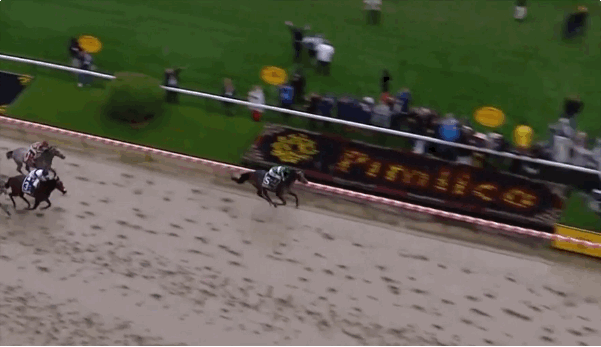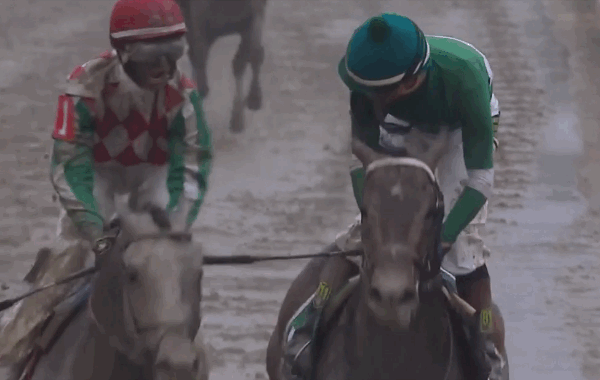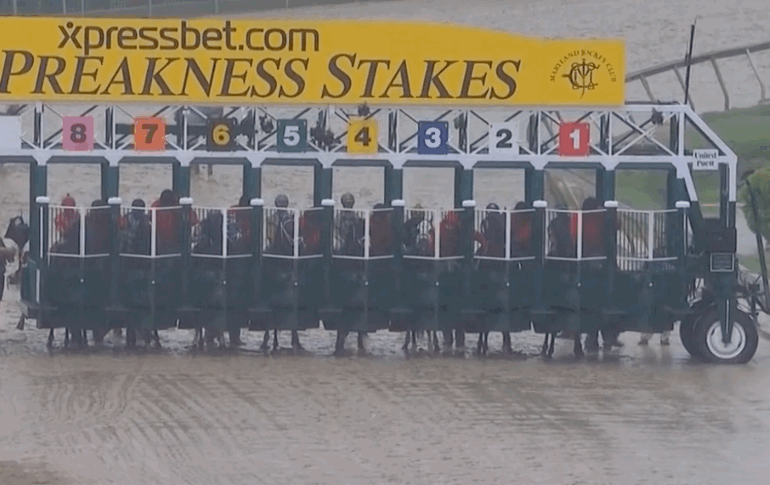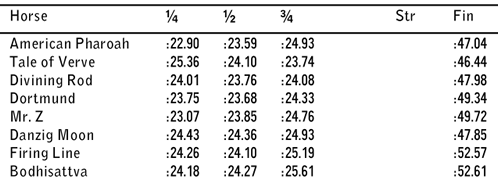Preakness Stakes

Bodemeister awaiting the walkover for the 2012 Kentucky Derby.
Always Dreaming is now at Pimlico and trainer Todd Pletcher has sketched out a light training regimen for the Kentucky Derby winner, reports David Grening:
Pletcher said Always Dreaming would simply jog Wednesday morning at Pimlico before beginning to gallop on Thursday. He reiterated Tuesday what he said Sunday morning — that the horse would not have a workout before the Preakness.
“I’m not going to breeze him no matter what,†Pletcher said. “He’s fit, that’s not an issue. Two mile-and-an-eighth races and the Derby and now back in 14 days, I don’t see any reason to do anything.â€
His win last Saturday sent me searching for things to read about both his sire, Bodemeister, and grandsire, Empire Maker, a son of Unbridled. Bodemeister finished second as the post-time favorite in the 2012 Kentucky Derby to I’ll Have Another after flying through the first six furlongs in 1:09.80, pressed by Trinniberg. Pat Forde recounts how he finished the race:
Yet instead of hitting the cardiovascular wall, Bodemeister actually opened up the lead in the stretch, threatening to shatter the barriers of equine endurance and defy more than a century of established Derby precedent.
“What kind of horse is this?†wondered Churchill Downs executive and resident Derby authority John Asher.
“The term that came to my mind was ‘Freak,’†said former trainer Elliott Walden, now president and CEO of WinStar Farm in Versailles, Ky. “To run those fractions and then open up at the top of the lane, it was just incredible.â€
(Bodemeister stands at WinStar.)
It was the way Bodemeister re-broke that flashed into my mind when Always Dreaming crossed the wire 2 3/4 lengths ahead of Lookin at Lee after chasing State of Honor through a swift first four furlongs in :46.53. It wasn’t that his final fraction was impressive (not at :26.32), but rather the stamina on display — it reminded me of American Pharoah, who’s by Pioneerof the Nile, another son of Empire Maker, and it was no surprise that in my searching, a relevant, prescient post by Sid Fernando popped up. Writing about owner Ahmed Zayat, trainer Bob Baffert, and the Unbridled line, Fernando observed:
Perhaps all of this will coalesce in a Derby victory for the owner, trainer, and sire line.
Spoiler! It did — American Pharoah was just two months old and three years away from winning the Triple Crown when Fernando wrote this piece in 2012.
It was via Fernando that I read this 2008 Jack Werk column about Pioneerof the Nile that included this detail about the 2009 Kentucky Derby runner-up:
“I’m really high on this colt,†he said. “The big thing with this colt is his tremendous lung capacity, and that’s really important for the Derby. In fact, I’m so high on the sire that we’re sending Indian Blessing and some other top mares to Empire Maker.â€
Empire Maker is now the 15th stallion to sire two or more sons who would produce Kentucky Derby winners, according to Blacktype Pedigree. “I think we can now officially refer to Empire Maker/Unbridled (also sire of Unbridled’s Song)/Fappiano as a hot two-turn Classic dirt sire line,” writes Bill Oppenheim.
It’s all an interesting fulfillment of the promise that Lauren Stich saw in Empire Maker back in 2007, at the beginning of his stud career:
Like A.P. Indy, Empire Maker not only has an impeccable pedigree, he also should be an important source of stamina in this country, a rare commodity in this era. While runners by Empire Maker should only improve with age and distance, some will certainly have tactical speed. Unbridled may be revered as a strong source of stamina, but he did thrash champion Housebuster going seven furlongs in the Deputy Minister Handicap at Gulfstream Park. And, thus far, the brilliant Unbridled’s Song has been Unbridled’s best son at stud, and is more of a speed than stamina influence.
Empire Maker’s offspring should not be as precocious as those of Unbridled’s Song, but they will be more effective at distances longer than one mile. Empire Maker’s runners should relish 1 1/4 miles and beyond, and I expect we will eventually see many of his 3-year-olds succeed in all of the Triple Crown races, possibly even in 2008, and every year thereafter.
It also seems like a good reason to trust Always Dreaming’s fitness for May 20, and that the qualities Kerry Thomas and Pete Denk discerned in the colt in their Brisnet Kentucky Derby analysis will likely hold up for the Preakness:
When rider John Velazquez let him go turning for home, Always Dreaming poured every ounce of emotional energy into his forward drive. He lengthened his stride and pulled away from the field to win by five lengths. This was a more determined, stronger version of Always Dreaming. This is a colt on a serious growth pattern.
His internal fractions of :47.34, :23.59, 24.02, :12.53 show an excellent mix of speed and stamina. His sensory system was still way out in front of his body at the wire (as a horse tires physically, that emotional extension shrinks). We think Always Dreaming is well equipped to get 10 furlongs.
Always Dreaming is a talented horse just coming into his own, getting stronger every race.
Related: Empire Maker’s profile on American Classic Pedigrees. See also, this story about Empire Maker returning to the US in 2015 after standing in Japan.
(Thanks to @superterrific and @jenmontfort for inspiring this post.)

Exaggerator wins the 2016 Preakness ahead of Cherry Wine and Nyquist.

And Corey Lanerie on the runner-up gives winning jockey Kent Desormeaux a pat on the back as they gallop out after the wire.
Exaggerator gets a Beyer speed figure of 101 for his Preakness Stakes win over Pimlico’s sloppy track on Saturday. TimeformUS gives him a speed figure of 122, the same number assigned Kentucky Derby winner Nyquist for running third, quashing a Triple Crown bid. The two go on to the Belmont Stakes for a rematch in three weeks, and now that Exaggerator has finally beaten Nyquist — in the fifth race featuring the two of them — we have a rivalry.
So, what about the mud? “Thank the good Lord for raining on us today,” said a member of Exaggerator’s ownership team in the winner’s circle. “You have to think that the track means a lot to his performances, but his fast-track performances are not bad, either,” said rider Kent Desormeaux.
And what about the pace? Pretty similar to the Kentucky Derby, with the slight difference that Nyquist pushed to the lead and moved into the front early. He ran the first quarter with Uncle Lino in :22.38, the first half in :46.56, and the first three-quarters in 1:11.97. Here are the DRF incremental fractions:

View the official Equibase chart (PDF).
Nyquist won the Derby despite chasing a quick first quarter and running his final quarter three seconds slower; it was an impressive performance. In the Preakness, he was tired, and Exaggerator, tracking on the rail, was in place to take advantage. “The colt shimmied up the backstretch like a seal, utterly enjoying it,” and Desormeaux rode with confidence. Watch the Preakness replay, and see how he angles out and into the lead in the stretch:
5/24/16 Update: Nyquist spikes a fever, will skip Belmont Stakes.

Sealed, opened, soaked: The condition of the Pimlico track surface became the X factor in the Preakness Stakes when a torrential downpour turned the dirt to mud minutes before post time on Saturday. If anything, the rain was a boon to the 4-5 favorite, already a winner on a wet track. But nothing can be taken for granted in a Triple Crown race: “I took a chance and sent him as quick as I can,” said rider Victor Espinoza, explaining how he hustled American Pharoah from stall #1 and into the lead from the start, outmaneuvering jockey Martin Garcia and stablemate Dortmund, in stall #2, at the break.
American Pharoah won the 1 3/16-mile race by seven lengths in a final time of 1:58.46, “the slowest for the Preakness since 1956, when Fabius was the winner over Needles and No Regrets on a fast track in 1:58 2/5.” Here are the individual fractions from the Daily Racing Form chart:

The winner’s split for the mile was :26.32, and for the final 3/16ths, :20.72 (both those numbers from the official Equibase PDF chart). So, American Pharoah slowed down at the end after a quick opening quarter, and I’m inclined not to read too much into what’s 1) a typical race shape for dirt routes, 2) a pretty good example of what we mean when we talk about tactical speed (see, not only the break, but the way American Pharoah draws away from the others rounding into the stretch), and 3) a finish without challenge (Dortmund checked out, Mr. Z tired out, and Firing Line never fired) over slop.
Jay Privman reports that American Pharoah earned a Beyer speed figure of 102. TimeformUS’ figuremaker gave him 125. He was awarded figures of 105 and 127, respectively, for winning the Kentucky Derby.
“I’ve never won this race as easily and handily,” said trainer Bob Baffert after. The ease does seem almost supernatural, or maybe that’s just the rain:
https://www.youtube.com/watch?v=SxXQASkvBjI
American Pharoah’s Preakness win was the sixth for Baffert; his Belmont Stakes start will be the trainer’s fourth shot at a Triple Crown, the third for Espinoza.
“It’s hard for me to imagine I’m going through this again,” the trainer told the NYRA press office on Sunday morning, and quipped that he’d like a fast track at Belmont. “Like the one Secretariat had. I’ll take that.”
The Belmont Stakes is June 6, and there are currently eight likely contenders, in addition to American Pharoah, including Preakness runner-up Tale of Verve, Peter Pan winner Madefromlucky, and Kentucky Derby runners Frosted, Materiality, Keen Ice, Carpe Diem, Frammento, and Mubtaahij.
British bookies are taking bets — Ladbrokes has Pharoah at even money.
1:15 PM Addendum: American Pharoah was the only horse to gallop back without a mud mask, thanks to his gate-to-wire run, but he was carrying a little extra water weight via Espinoza’s boots.
Copyright © 2000-2023 by Jessica Chapel. All rights reserved.